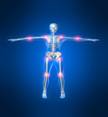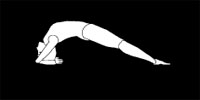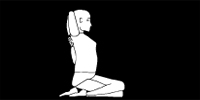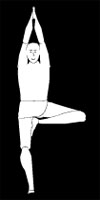INTRODUCTION
Arthritis encompasses a group of ailments involving damage to the joints in the body. Arthritis is a joint disorder featuring inflammation. A joint is an area of the body where two different bones meet. A joint functions to move the body parts connected by its bones. Arthritis literally means inflammation of one or more joints. Arthritis is frequently accompanied by joint pain. Joint pain is referred to as arthralgia. The most common type of arthritis is called osteoarthritis.

ARTHRITIS AND YOGA
Holistic (or mind-body integrating) movement practices with origins in eastern philosophy and culture are receiving a great deal of attention recently. Yoga is a set of theories and practices with origins in ancient India. Literally, the word yoga comes from a Sanskrit work meaning "to yoke" or "to unite." It focuses on unifying the mind, body, and spirit, and fostering a greater feeling connection between the individual and his/her surroundings. Yoga is an ancient practice using a system of postures and breath controls, which aim to achieve the perfect union of body, mind and spirit.

YOGA POSES FOR ARTHRITIS
Single Leg Raises
This Yoga Pose is performed in order to prepare the body for other exercises. It benefits the legs, lower back muscles, and abdominal area. In practicing the Single Leg Raise, one leg is raised while the other one stays on the floor.
Standing Side Stretch Pose
The Standing Side Stretch is another Yoga Pose with two lines of energy radiating outward from your center. This is a simple Yoga Posture with a wonderful stretch in which one line of energy reaches upward from your belly and outward through the arm, and one line travels downward through the legs.
Hand Clenching
Hands and wrists are common body parts which are affected by Arthritis, especially Osteoarthritis. Take good care of your hands and joints and always keep them in 'good working condition' by performing the Hand Clenching Exercise.
Wrist Bending
Your wrists can also be affected by arthritis, specifically Osteoarthritis and Rheumatoid Arthritis. Take good care of your wrists through stretching and bending. Learn how to improve the range of motion of your wrists by doing the Wrist Bending Exercise.
Ankle Bending
Repeated strain or sprain in the ankles can contribute to the occurrence of Ankle Arthritis. Manage stress and keep your ankles in good condition through therapy, having enough rest, and by doing the Ankle Bending Exercise.
Ankle Rotation
Pay attention to your ankles to avoid muscle or tendon strain due to too much training. Perform the Ankle Rotation Exercise and make your ankles more flexible. This is also ideal for people who are suffering from arthritis.
YOGA ASANAS FOR ARTHRITIS
SANTULAN ASANA
Santulan Asana has curative and corrective effects upon the knees, ankles, shoulder joints, wrists, palms and fingers. It removes rigidity and brings flexibility to the major joints of the body normalizing the blood circulation in the affected areas and tones up the muscles so pain in the joints is corrected.
Steps
• Standing up on the right leg, bend the left leg at the knee. Bring the heel of the left leg near the hip. If the heel cannot be brought nearer the hip due to pain in the knee, fold the leg backward as much as possible.
• Grab the toes of the left leg with the left hand holding all the toes with the palm properly. Bring heel of the bended leg to the buttock.
• Now slowly raise the right hand firmly up towards the sky with palm in the straightforward position.
• Retain this position for 6 to 8 seconds. Keep the lifted hand tight and firm. The right leg on which you are standing should be tight and straight. Keep looking straight and breathe normally.
• Slowly bring the lifted hand down, keeping it in a tight condition. Do not drop the hand. When the raised hand has reached the side, release the left leg to come on the floor. Now rest for some time and do further rounds alternately by following the same process.
SETUBANDHASANA

Regular practice of this asana helps in mitigating painful conditions in diseases like arthritis, cervical or lumbar spondylysis and Sciatica. It also helps in strengthening the muscles of the chest, hips, shoulders and hands.
Steps
• This posture involves stretching of the posterior muscles of the body.
• While sitting, stretch your legs forward and keep them close to each other. Bend a little forward, make hooks of your fingers and hold the big toes on the respective sides.
• While exhaling, bend forward stretching the trunk along the thighs. Rest your on the knees, which should be kept straight.
• Gradually, the tense muscles can be made supple for securing the complete posture. Inhale and return to the original position.
GOMUKHAASANA

Gomukh Asana has corrective and curative effects upon all the major and minor joints of the body. It exercises the finger joints, the elbows, the shoulder joints, the toes, the ankles, the knees and the hip joints very effectively. All the muscles and nerves related to various joints are automatically toned up, activated and normalized.
Steps
• Inhaling slowly through the nostrils bring right hand to the back. Bend it at the right elbow and then raise the back of the palm up towards the neck. In this process the back of the palm is pressed against the spine. The fingers of the right hand face upwards.
• Now raise left hand upwards bending at the elbow and put the left palm on the left shoulder. Then, first try to touch the fingers of the left hand with the right hand. If there is any difficulty in touching the fingers to some individuals, they should try as much as possible and then stay there.
• Try to raise the elbow of the left hand straight upwards (with the lock). Breathe normally. This is a Gomukh Asana.
• Retain this locked position for about 30 sec. You can either hold the posture while the breath is held or you can try holding the posture while breathing gently through the nostrils. If you choose to breath, then hold the posture for thirty seconds to a minute.
• While releasing the posture, loosen the grip on the fingers and then unlock the fingers gradually. Then slowly bring both the hands on the thighs and rest.
SKANDHA KATIASANA
This asana strengthens the abdominal and vertebral muscles. It is good for patients suffering from arthritis, stiff back, respiratory disorders, diabetes and constipation.
Steps
• Lie on your back gently, bend both the legs at the knees and bring your feet near the tips. While inhaling, slowly raise hands and shoulders and try to touch the knees. Retain this posture for a few seconds.
• While exhaling, return to the starting position.
VRIKSHA ASANA

In this asana all the muscles are stretched and so it tones up the muscle of the ankles, toes, knees, hip joints, shoulder joints, elbows, hands and fingers. Overall it brings flexibility to the body and removes all the strains activating all the joints of the body
Steps
• Stand up firmly on the left leg and fold the right leg at the knee, raise the right thigh and bring the sole of the right foot as high up the inside of the left thigh as possible. Right foot will be twisted slightly pressing its side against left thigh. Do not press the thigh with the heel but with its sides.
• Balance on the left foot and raise both arms over the head keeping the elbows unbent and joining the palms together. The whole body right from the heels to the fingers of the hands is stretched upward. Hold the posture while breathing gently through the nostrils for about 10 complete breaths.
• Release the pose exhaling, lower the arms and right leg and return to the tad-asana, standing position with feet together and arms at the sides. Rest for a few seconds and repeat on the opposite leg.
KATICHALANA

This asana is very good for relieving back pain and also helps in digestion and joints pains. It maintains the omen, hips chest, knees, shoulder and spine.
Steps
• Lie flat on your back, bend your legs at the knees and bring your feet near the hips. Interlock the fingers of both your hands and keep them under the head. Now exhale and put a little pressure on the waist. Twist your knees to the right, simultaneously turning your head and neck to the left. Maintain normal breathing. Again, while exhaling, twist the knees to the left turning the head and neck to the right. Repeat this three to four times on each side. Return to the normal position and then relax. Like Katichalana (cross leg-twisting pose) lie in Shavasana, bring legs together and hands together. Fold both your legs and cross right over the left. Inter-locks finger of both your hands and keep them under your head. Look towards the left and vice versa. Change the leg, left over the right. While exhaling, twist the leg right and look at left and vice versa. Maintain the final position for a minute, breathe normally and return in reverse order.
ASTROLOGY
Yoga’ is a Sanskrit term which means 'to unite'. What is being referred as the ‘Yoga’ in English, is more commonly known as ‘Asana’ in Sanskrit, which means different physical postures and poses. It is seen that people of a particular sun sign find it beneficial when they practice certain yoga asanas. According to astrological reports for yoga asanas the above mentioned asanas are said to be effective for those who come under the following zodiac sign
• TAURUS
• LIBRA
• VIRGO
• AQUARIUS